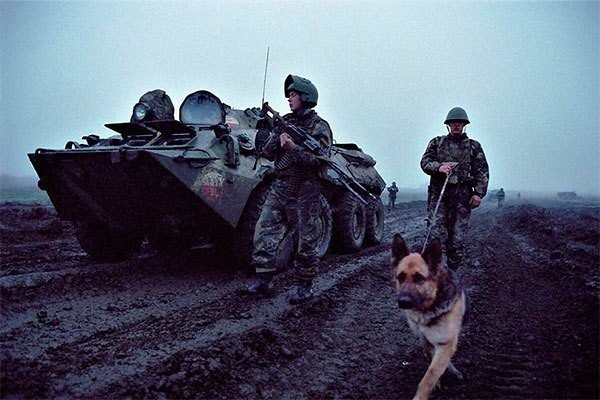
Aircraft creation
This plane is forever in the history of our aviation
countries not at all because of outstanding flight performance or participation in combat
conflicts. MiG-9 became the first Soviet aircraft with a turbojet engine,
who took to the air 24 April 1946 of the year. Exactly, not the first
Soviet jet, how mistakenly write in some articles in
The internet. BI-1 is also a jet plane and made its first flight much
before - 15 May 1942 of the year.
Even during the war, the Soviet Union began to arrive
intelligence on the development of fighter jets in Germany,
UK and USA. USSR lagged far behind in this area, what caused
concern of the country's leadership. In February 1944 year decree
The State Defense Committee was commissioned to organize
Research Institute of Jet Aviation (NII-1) for creating
jet engines. A design bureau Yakovlev, Mikoyan, Lavochkina and
Sukhoi gave an indication of the beginning of the design of fighter jets.
There was no clarity at that time, which of the reactive
engines more promising. Therefore, the designers were instructed to create
fighter jets based on all, that existed at that
time - turbojet engine, Liquid propellant rocket engine and engine (VRDK). The most
interesting, what A.S.. Yakovlev distrusted a new kind of technology and
expressed his opinion to the leadership of the country, calling german jets
"Senseless adventure".
The most basic problem when developing a new look
technology was with engines. Ready turbojet engine was not, A.M. Cradle for a long time
created and brought his engine TR-1. Tests of aircraft with rocket engine and engine
showed the futility of the development of these schemes and aircraft based on them on
tests have not shown their combat value.
At the end of the war, captured German specialists Jumo turbojet engines fell into Soviet hands 004 thrust 900 kgf and BMW-003 thrust 800 kgf. This dramatically accelerated the creation of jet aircraft. The only decision that was right at that time was made to copy and produce engines based on German. In mass production, Jumo engines 004 and BMW-003 received the designation RD-10 and RD-20, respectively.
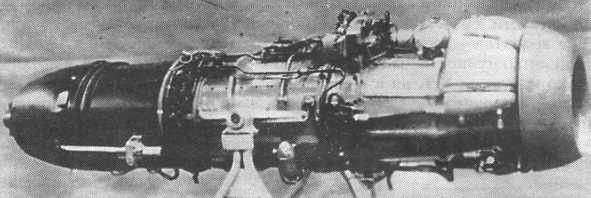 RD-20 engine
RD-20 engine
But besides problems with engines before designers
there were other equally difficult tasks. It was necessary to resolve issues of common
aerodynamic layout and the problem with the so-called wave crisis.
spring 1945 years, Mikoyan Design Bureau began designing a single-seat twin-engine jet fighter. Initially, an engine layout was developed on the wing under the influence of German Me 262. Project with two BMW-003 received the designation I-260, with two jumo 004 - I-290. Yakovlev on the Yak-15 used a revised engine layout. The following disadvantages were characteristic of this circuit.: a hot jet of hot gases heated the bottom of the fuselage (and with the chassis like the Yak-15, the tail wheel also) and created a vacuum under the horizontal tail, the inclined position of the turbojet engine could affect the stability of the work.
According to the memoirs of the designer E.G.. Adler Yakovlev had doubts about the correctness of the chosen scheme and he shared them with Mikoyan thereby, prompting the idea to a competitor. And according to Adler, the student technically surpassed his mentor.
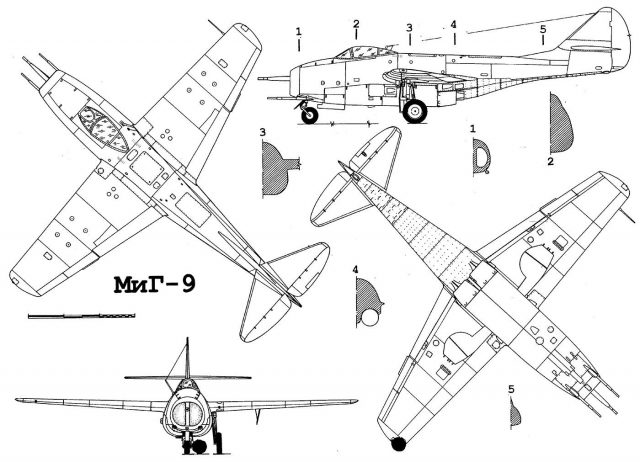
After this meeting of two designers in June 1945 years, Mikoyan Design Bureau began work on a twin-engine fighter of the redanny scheme, received the code "F" and the designation I-300, and work on the I-260 and I-290 aircraft were curtailed. If the Yak-15 was developed on the basis of the already well-developed Yak-3, then the Mikoyanites created a completely new plane. With the selected layout, in comparison with the placement of engines on the wing, drag was significantly reduced, which increased flight speed, and the “clean” wing improved aerodynamic quality (the range of the aircraft increases accordingly).
 The difference in the layout of the MiG-9 engines is clearly visible. (left) and Yak-15 (case)
The difference in the layout of the MiG-9 engines is clearly visible. (left) and Yak-15 (case)
Engines for the future fighter chose BMW-003 despite slightly less traction, than Jumo 004. Caused it was BMW's smaller maximum diameter-003 (facilitated the placement of two adjacent
engines) and a bit more compression, which increased altitude
Aircraft. The close proximity of engines improved handling in case of
failure of one of them and allowed safe flight on one
engine.
At the same time, such a close location
forced designers to solve issues of forced cooling of the engine
compartment and lower fuselage. It was especially difficult to solve the second problem.,
since the temperature of the gases behind the nozzle was about 700 degrees, and aluminum
alloys, as is known, can not withstand heating more 120 degrees. AT
as a result, the lower skin was made double of duralumin 0,5 mm and heat resistant steel 1,2 mm with a gap between them
at 15 mm.
The resulting space was purged with outside air, which acted
through two air intakes on the side of the fuselage, established in
flap area.
Three-rack chassis with nose wheel, Unlike
chassis with tail support on the Yak-15, excludes exposure to hot gases
the engine on the runway and significantly improved visibility when taxiing, landing and takeoff.
With increasing speeds in aviation, designers are faced with the problem of a wave crisis (a change in the nature of the airflow around an aircraft as the flight speed approaches the speed of sound, accompanied by, usually, deterioration of the aerodynamic characteristics of the apparatus - an increase in drag, lower lift, the appearance of vibrations, etc.). In the case of wings with a relatively thick profile, in the conditions of a wave crisis, the center of pressure sharply shifts backward and the nose of the aircraft becomes heavier..
Piston fighter pilots with such a wing, trying to develop top speed dive from high altitude at maximum power, when approaching the “sound barrier” they became victims of the wave crisis - once in it, it was impossible to get out of the dive, without extinguishing the speed, which in turn is very difficult to dive. This was the main cause of the crash of the BI-1 aircraft. 27 Martha 1943 years in which test pilot Grigory Bahchivanji died.
On the Yak-15, the wing remained from the Yak-3 with the Clark-YH wing profile. For this reason
the speed was limited by the number M = 0.68 and strength (instrument speed 700 kmh). In this way,
the plane could not fully use even a small thrust of one engine.
Designers of the Mikoyan Design Bureau to reduce wave drag assembled a wing of new TsAGI high-speed profiles with a relative thickness 10% (on the Yak-15, the relative thickness of the wing at the root 14%). As a result, the MiG-9 managed to get speed 911 km / h at an altitude of 4500 m, and the Yak-15 did not exceed 800 kmh.
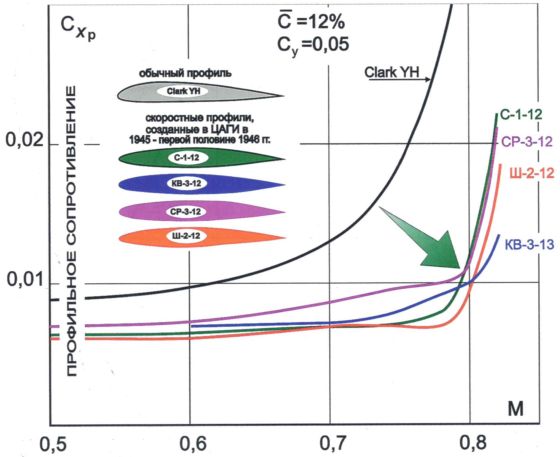 Reduced aerodynamic drag using new TsAGI high-speed profiles. The graph clearly shows why the Yak-15 with the Clark-YH profile was inferior in speed to the MiG-9
Reduced aerodynamic drag using new TsAGI high-speed profiles. The graph clearly shows why the Yak-15 with the Clark-YH profile was inferior in speed to the MiG-9
Taken on a Mikoyan fighter technical
solutions allowed to create an aircraft with higher performance characteristics compared to the Yak-15.
The first prototype I-300 (F-1) was made in
December 1945 of the year. And the decision of the Council of People's Commissars of the USSR No. 472-191 with the terms of reference for
created new jet fighters came out 26 February 1946 of the year. Aircraft
had to have maximum speed near the ground 900 kmh, on high 5000 m - 910 kmh, dial time
height 5000 m
- 4min, practical ceiling - 13000
m, range of flight - 820 km, weapons - one
57-mm or 37 mm gun and two 23 mm.
For four months to March 1946 year plane
passed ground tests, then 23 March, the car was transported to LII g.
Zhukovsky.
Comparison with analogues
When comparing the main characteristics of aircraft in
First of all, the strong lag of the USSR in engines is noteworthy..
The leaders of the US and UK engine building are already on serial fighters
were more powerful thrust engines from 1400 to 1800 kgf. Two RD-20 engines
MiG gave less traction, than one Allison J33 on the P-80 Shooting Star. It seemed, this
gave western cars a chance to break far ahead. Really, aircraft
Meteor F.4 and P-80R (special record modification) set world records
velocity 7 September 1946 year and 19 June 1947 , respectively, and showing
velocity 991 kmh
and 998,08 kmh
respectively.
The main performance characteristics of the first production jet aircraft:
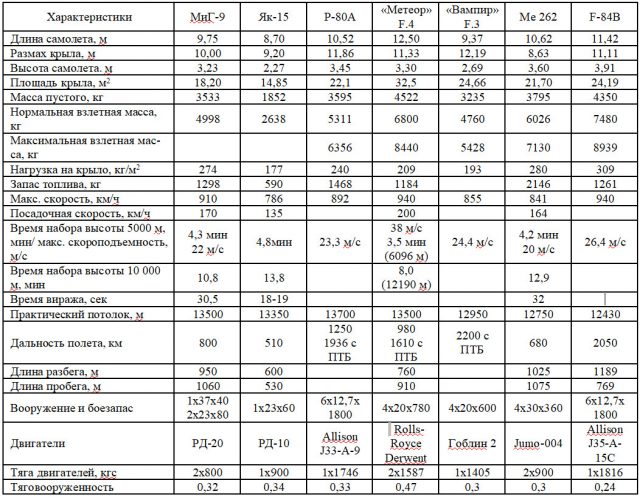
These record numbers were reached near the ground., where is the speed
sound has a maximum value and the number M reached by them was equal to 0,8-0,82.
For production aircraft, same as on the MiG-9, restriction was established
M = 0.8. ie. the successes of English and American engine builders leveled
lack of real success in aerodynamics. So the first domestic jet
not yet perfect fighter did not lag behind competitors in the field
aerodynamics and its flight characteristics were at the level of leading countries. other
a business, that western cars were tested and adopted by several
years earlier and with the rapid development in those years of jet technology the MiG-9 is quite
quickly out of date.
Competitors' aircraft also quickly became obsolete, but
were in service much longer and were produced in large quantities. So
the P-80C was
withdrawn from service in the US Air Force in 1958 year (in the air force of Uruguay in 1975 year), actively
used in the korean war. All were released more 1700 "Old Shooting", a
on the basis of it was created a very successful training aircraft T-33, issued in quantities over 6000 copies,
which commissioned young US pilots right up to 1975 of the year. "Meteor" was
in the ranks before 1961 of the year. Mikoyan fighters with such successes
could not boast.
The reasons for this were, that our MiG-9 had a very narrow
specialization - interception of high-altitude piston bombers, had a lot
design flaws, engine life was very small, as
training was not suitable for use and
after the appearance of the MiG-15 just did not find a use for itself. Even the Chinese
considered it obsolete at the time of transfer to 1950 year.
Western cars were easier to operate, found application in the future as attack aircraft, fighter bomber (MiG-9, in principle, could not be used in this capacity due to the lack of bomb and missile weapons) and training aircraft. For poor countries, these aircraft were simple and inexpensive to operate and were in service until the 70-80s. Absolute record holder — training T-33 retired from Bolivia's armament 2017 year!
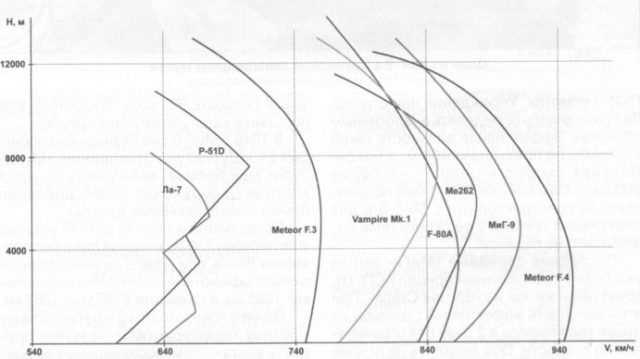 High-speed characteristics of post-war aircraft
High-speed characteristics of post-war aircraft
From the graph you can see, that the MiG-9 in flight performance was superior to all the first jet aircraft, except for Meteor F.4. But in terms of combat qualities, he could not compete with his rivals.. In terms of range, domestic aircraft traditionally lost to adversaries until the appearance of the Su-27. With the use of PTB, the difference increased significantly. In Mikoyan Design Bureau, a modification was developed with two 260 l tanks, which increased the range to 1100 km. In this case, restrictions were imposed on speed and permissible overload (600 km / h and 2,5 meals. respectively). In the series, this option did not go.
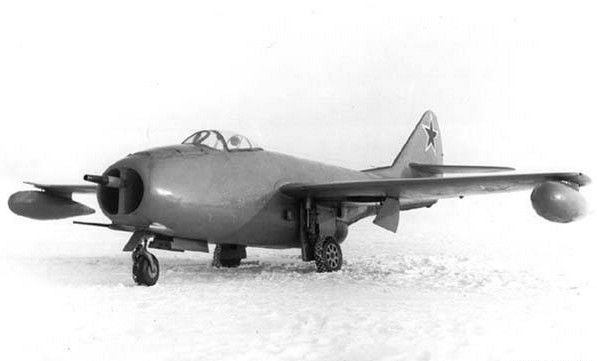 MiG-9 with hanging tanks for testing
MiG-9 with hanging tanks for testing
For actions on ground targets, the MiG-9 was not intended at all, not having the appropriate arsenal in their armament. Shooting Star and Vampires (in variant fighter-bomber) could carry to 907 kg bomb load, "Meteor" — 454 kg, being able to use unguided missile weapons.
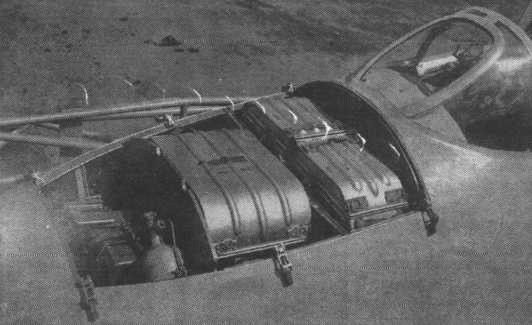 MiG-9 ammunition boxes
MiG-9 ammunition boxes
The American P-80A was superior to the MiG-9 in horizontal maneuverability and rate of climb. The guns of our fighter were more powerful, but had significant limitations on use. Yes, and six trunks 12,7 mm was enough for an american to hit any air target. Ammunition on 300 cartridges for the barrel of machine guns Colt Browning M2 / M3 was not superfluous and could be useful not only in aerial combat, but also against ground targets. In general, Shuting Star is preferable in this matter., with the exception of, bomber interception applications, where the power of 37 mm and 23 mm, combined with better speed indicators, leads Mikoyan leaders.
Initially, the MiG-9 had a primitive PKI-1 sight, and anticipation had to be done “by eye”, which reduced the chances of successfully hitting a target, especially maneuvering. At the last serial “moments” there was a more perfect ASP-1N sight, similar to the American ones in terms of characteristics.
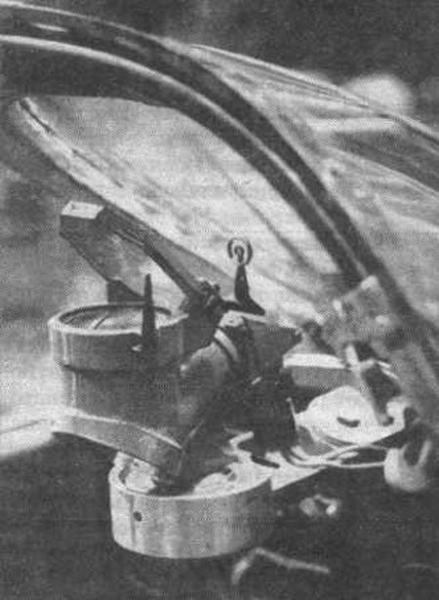 PKI-1 sight
PKI-1 sight
Subsequent modifications of the P-80 completely surpassed according to flight data of the MiG-9 as
in speed, and climb.
The first modifications of "Meteors" were much inferior in characteristics to the "instant", unsurprisingly, since their first flight was made during the years of the Second World War. A, starting from modification F.4, completely surpassed our aircraft according to flight data. The English plane was especially strong in climb and top speed on the ground. (more than 100 kmh). MiG-9 prohibited negative overload, Meteor could hold a minus for 15 seconds. true, over maximum permitted overload 8 meals. against 6 meals. Stalin's first-born jet won.
The second volley of four 20mm British Hispano Mk.V cannons was 6,5 kg, and on the MiG-9 in total 3,6 kg. There were no restrictions on firing on British guns, except for the duration of the shooting no more 15 seconds. The armament included bombs and missiles. Thus, the Meteor exceeded our aircraft in all flight technical parameters and combat effectiveness.
In operation, our technicians could only envy
the English. The Meteor refueling lasted three times shorter - 20 minutes, resource
engines was not less 150 hours. Complete superiority over the “instant” impressed
our designers and the leadership of the USSR even tried to agree with the recent
ally about the purchase of several copies of this fighter, but relationship
between the countries has already deteriorated - the Cold War began.
And even a lower-speed “Vampire” F.1 was better in combat capabilities of the MiG, about what
says a large number of manufactured aircraft and their modifications and export to
more 30 countries of the world.
F-84B appeared a little later than its brothers in arms.
The first flight of his prototype made 28 February 1946 of the year. The first modifications to this
aircraft were unsuccessful, there were a lot of structural defects and technicians got
nickname "nightmare of mechanics". But by the beginning of the Korean War, Ripablic firm brought
to mind your plane and he became a good fighter-bomber. AT
later a swept wing was installed on it and according to its characteristics he left
far ahead of the MiG.
conclusion
Among the first jet fighters, the MiG-9 did not gain worldwide fame. He quickly flashed in the history of aviation of the Fatherland, without leaving a bright mark. The Air Force has been in service 5 years - from 1946 by 1951 years. Created in the years when progress in aviation was fast. He appeared later than his competitors and made in a hurry.
Despite good flight data, a real military unit did not work out of it. But it’s impossible to call him completely useless or worthless. It could be used successfully only as a day fighter-interceptor. The MiG-9 played its main role in gaining design experience., building and mastering new technologies. The personnel of the pilots and technicians of the USSR Air Force gained invaluable experience in operating a new type of aircraft. Without all this, there would be no further success with the MiG-15.
MiG-9 played an important psychological role, participating in air parades. The presence of modern jet aircraft in the arsenal of the USSR was demonstrated to a potential enemy, creating the appearance of mass entry of equipment into the troops, which was unexpected for the leadership of leading Western countries, intelligence who cheerfully reported the impossibility of quickly setting up production of jet aircraft in a war-torn country.
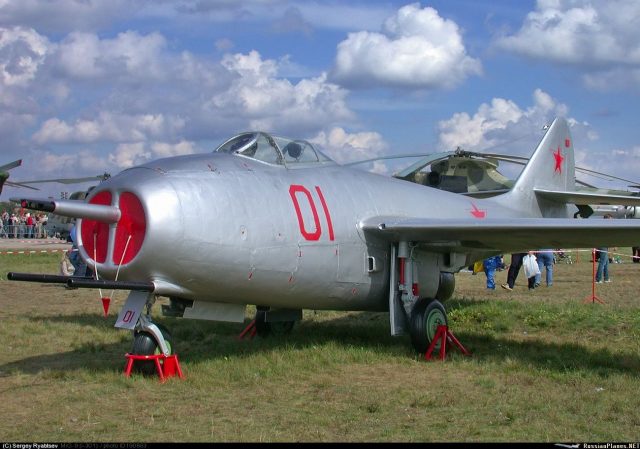 This serial aircraft participated in the filming of "The Sky Is Subjugated to It". The plane for the film was restored to flight condition but only made short approaches on the set.. Now on display in Monino.
This serial aircraft participated in the filming of "The Sky Is Subjugated to It". The plane for the film was restored to flight condition but only made short approaches on the set.. Now on display in Monino.
You can not remain silent about the designers, engineers and
simple workers, created in quite a short time a completely new technique,
worked days and nights to create an air shield of the motherland. leadership
countries were able to effectively organize in a country destroyed by war a massive
production of jet technology. Modern "effective managers" are most important
personal profit and similar complex tasks are beyond their power.
MiG-9 and Yak-15 aircraft were the first-born in their business and
were crucial in the formation of jet aircraft in the country. Highlight
the best one doesn't make sense, each has its niche in the country's aviation.
Read more about the creation of the Yak-15 and its comparison with the Mig-9 in the next article.
I want to say thanks to everyone who has read the article. In the comments, constructive criticism of the author and respect for each other are welcome.
Used Books:
- Aviation and Cosmonautics / E. Arsenyev — Aircraft Design Bureau named. A.I. Mikoyan
- Aviation and Time 2016-02 / A.Chechin — Front fighter (MiG-9 aircraft)
- Aviation and Cosmonautics 2018-11 / G. Serov — Storm Barrier Assault
- World aviation. Issue No. 35
- Aviation Historian 03 / В.Котелников — The ultimate war prize
- Shavrov VB. History of aircraft construction in the USSR 1938-1950 gg.
- Yakubovich NV. All MiGs. Mikoyan's combat aircraft.
- Yakubovich NV. Reactive first-born of the USSR.
- Yakubovich NV. Yakovlev's combat aircraft.
- Sites aviadejavu.ru and airwar.ru
/Andrey Tischenkov, especially for «Army Herald»/








